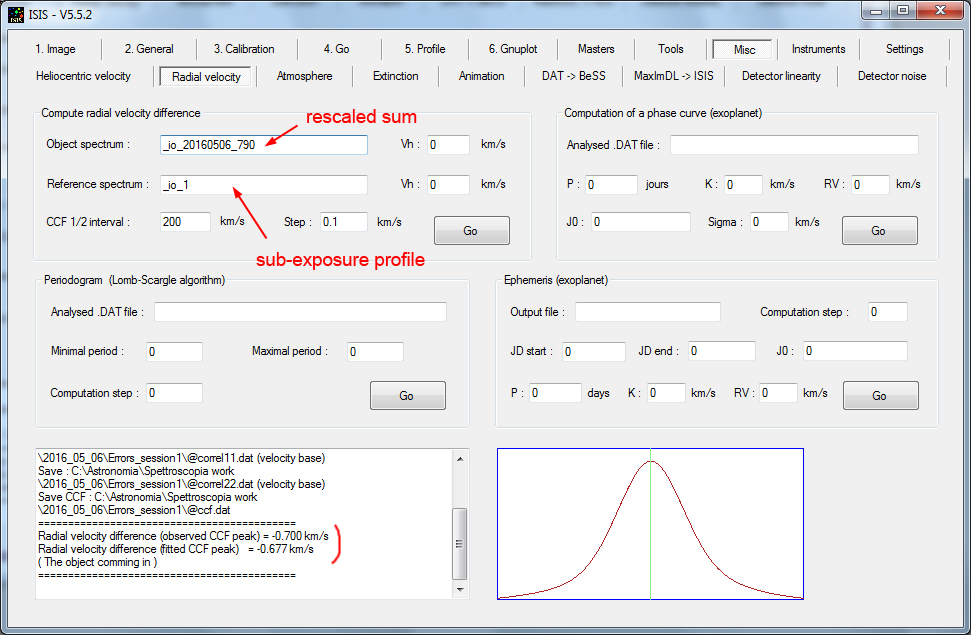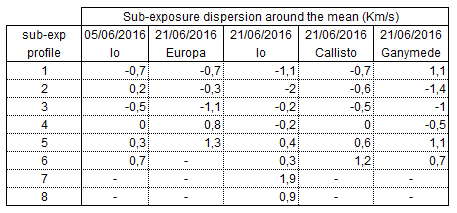On may 5 I took the spectrum (R~4300, Lhires III with 1200 l/mm grating) of Jovian moon Io (exp 6 x 120s) and Jupiter (12 x 5s). Spectral range was chosen to include a good number of strong absorption lines.

Each satellite sub-exposure profile has been calibrated using two reference lamp spectra taken before and after. Then, the final profile was obtained by adding them. The aim is to reduce the thermoelastic effects on the spectrograph as much as possible.
Jupiter profile was calibrated with only begin/end averaged lamp spectra because the integration time is very short. The wavelength calibration of the planet spectrum is the most critical due to the shift caused by its rotation (spatially extended disk on the slit). The binning zone for the profile extraction was selected in the center of 2d spectrum axis.
Observed relative radial velocity value is as follows:
Io vs Jupiter: -33.7 Km/s
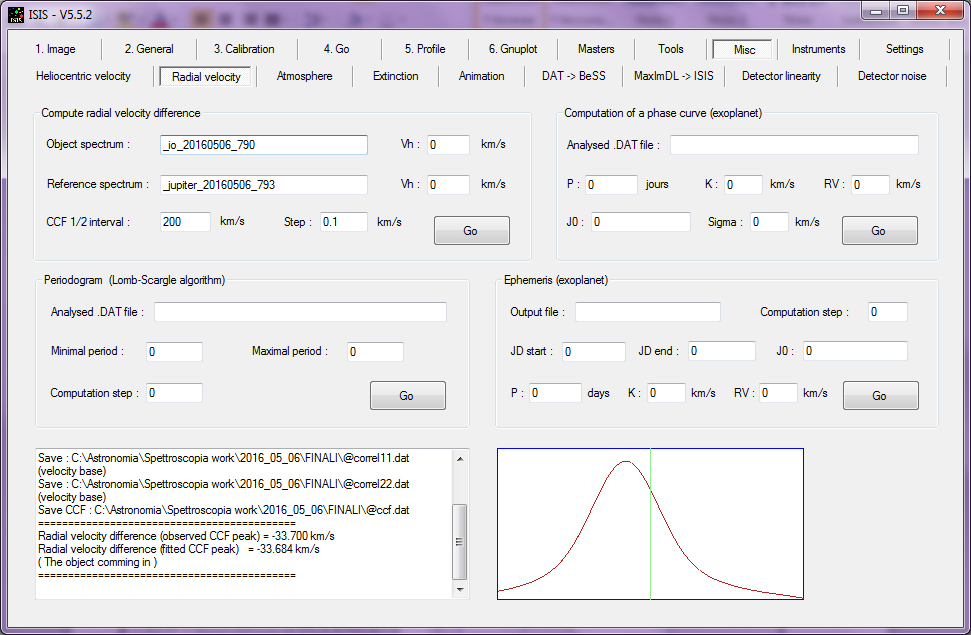
Reflected light doubles (in ideal opposition condition) any observed radial velocity values. We have to consider the Sun->Target->Observer angle. An approximate formula is: 1 + COS(angle). At observing date, the S-T-O angle was 9.5 degree (from ephemeris), so the divisor is very close to 2 (1.986).
The relative radial velocity values corrected for the reflected light becomes:
Io vs Jupiter = -33.7 / 1.986 = -17.0 Km/s
A first check is possibile with ephemeris. I used the NASA Solar System Dynamics (HORIZONS Web-Interface), if anybody knows other ways to verify the results, please let me know.
From SSD, I have referred to “deldot” parameter, which is the radial velocity of the observed target.
deldot Io: 7.1 Km/s
deldot Jupiter: 24.3 Km/s
Relative radial velocity (Io vs Jupiter) from ephemeris is 7.1 - 24.3 = -17.2 Km/s. This is very close to -17.0 Km/s found with ISIS correlation. The velocity value is also compatible with the position along the satellite orbit. Indeed Io had recently passed the maximum elongation point from Jupiter at the observation time, while moving with an orbital velocity, known from literature, of 17.334 km/s (mean value).
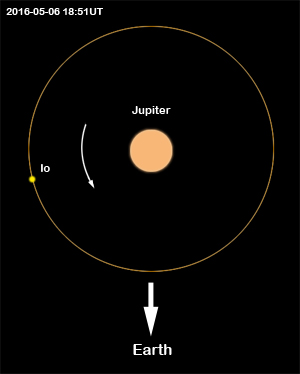
The scenario:

Both Io and Jupiter was moving toward the Earth but ephemeris deldot values are positive because the Earth move away faster along its orbit around the Sun. Indeed, the Earth velocity along the Earth-Jupiter direction is 26.2 Km/s (heliocentric correction is negative):
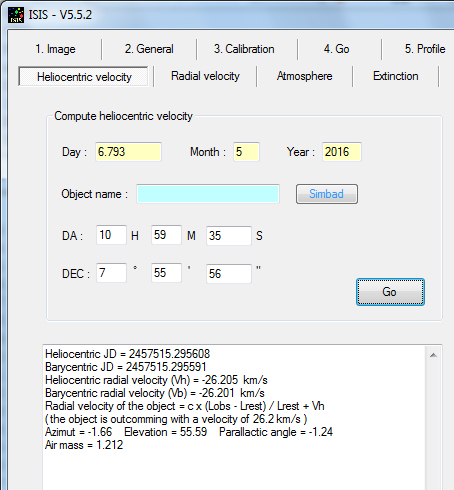
The small velocity component of Jupiter orbital motion along the Jupiter-Earth direction is: 24.3 (from SSD ephemeris.) - 26.2 = -1.9 Km/s.
To try to measure this very modest quantity, we should find the correlation between Jupiter and a reference spectrum (rest wavelengths). As reference profile I averaged six Sun spectral profiles available from Elodie 3.1 library (perhaps there are better ways to find a G2V reference profile…).
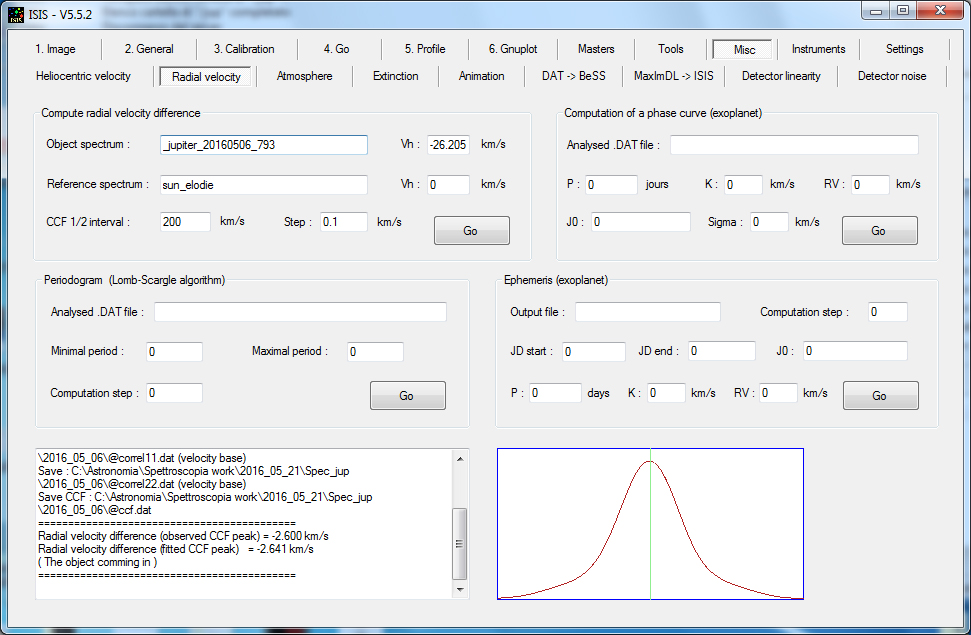
ISIS correlation provide the result value -2.6 km/s. Halving it to compensate the light reflection, the measured radial velocity is about -1.3 Km/s.
I realize that these can be measures over the limit of the equipment and techniques used. To check again the method and associated errors, on 21 May (bad weather meanwhile…) I observed again the Jupiter system, this time adding the other Galilean satellites.
The scenario during the observing session:
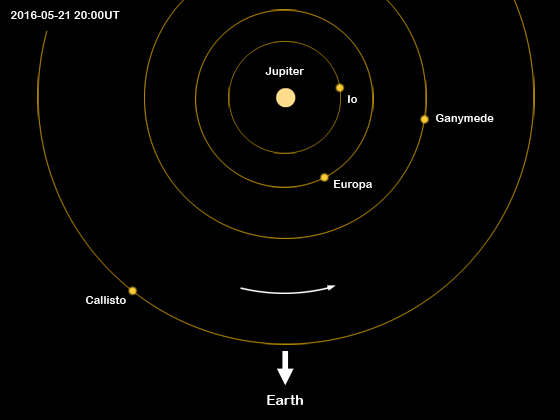
Time table and results of observations:

Error magnitude (in red) respect to SSD ephemeris seem to me not large again, considering the spectra resolution and the relative small spectral range used for the correlation. Much better results should come out from echelle spectrographs (see the tau Boo exoplanet observation by Christian for example).
I believe the ISIS CCF function is a very powerful tool. Any unexpected error here is due to my not proper conduct of the operations. Relative Rv measurements (i.e. between satellites spectra observed in the same session) are likely easier than absolute estimates. Systematic errors in the calibration of the spectra (offset) are very dangerous (I think to the different injection of light into the slit between star light and the calibration lamp beams).
I attach the relevant profiles if anybody want to play with:
http://quasar.teoth.it/html/jup/spec_jup.zip
Please let me know for any mistake I might’ve done, suggestion or other…
Clear skies,
Paolo

